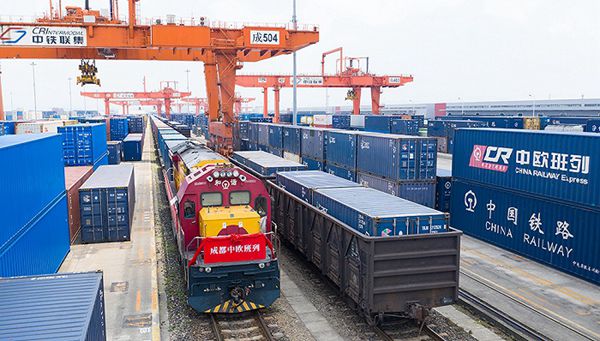The operation of China-Europe freight trains has maintained strong growth this year, with a total of 10,030 trains running by the end of August, according to data released by China National Railway Corporation On Tuesday.
It is also the 16th consecutive month since May 2020 that China-Europe freight trains have operated more than 1,000 trains a month, and the fourth consecutive month since May 2021 that china-Europe freight trains have operated more than 1,300 trains a month.
More and more lines cover, more and more frequent, more and more goods... Along the way, the China-Europe freight train is becoming more and more popular. At present, 73 routes have been laid out, connecting more than 170 cities in 23 European countries and carrying more than 50,000 kinds of goods.

A person in charge of the freight department of China Railway Group said that in recent years, railway authorities have continuously played the role of the strategic channel of China-Europe freight trains, strengthened transportation organization and improved operation quality. Especially since the beginning of this year, China Railway Group has further improved coordination mechanisms at home and abroad in response to the strong demand for China-Europe freight train transportation, made every effort to undertake the transfer of goods by sea and air, improved port transit capacity, and promoted the safe and stable operation and sustained strong growth of China-Europe freight train.
In order to upgrade the development of China-Europe freight trains, railway authorities have carried out projects to expand the capacity of ports and stations at Alashankou, Khorgos, Erlian and Manzhouli, effectively increasing the inbound and outbound capacity of china-Europe freight trains. From January to August, there were 5,125 trains on the west, 1,766 trains on the Central and 3,139 trains on the east routes, up 37 percent, 15 percent and 35 percent year-on-year respectively.
At present, due to the impact of the epidemic, international market demand and international logistics are greatly restricted. As the international shipping capacity is further strained and freight rates continue to rise, China-Europe freight train has become the choice of many foreign trade enterprises with its unique logistics advantages and powerful transportation system.
In Shandong province, in the first half of this year, jinan "Qilu" China-Europe freight train added five new routes including Helsinki, Barcelona and Frankfurt, running 378 china-Europe freight trains, up 35.5% year on year. The import and export value was 3.89 billion yuan, up 76.4% year on year.
In Hunan, Zoomlion, a leading construction machinery company, used to ship goods by sea, but now adjusts the size of its large machinery to fit the container size requirements of the trains. Ye Hongbin, general manager of Hunan Zhongnan International Land Port Co., LTD., which operates the China-Europe freight train (Changsha) route, said that zoomlion's logistics time has been cut by nearly two-thirds through the logistics plan of the Changsha to Minsk special train.
In order to further meet market demand, CEIBS continues to promote market-oriented reform. Under the condition of limited shipping space, we develop specific markets and products, such as "Chunli" Shengzhou tea special train, Chengdu China-Europe Cross-border e-commerce B2B export special train, Chongqing Xineurope electronic products special train, etc.
The opening of special trains makes it more convenient for enterprises and markets along the railway. In 2020, 101 geely special train of "Yixin Europe" will run, realizing point-to-point land transportation from the factory, integrating the logistics network of Geely factories passing through the China-Europe freight train, reducing costs and promoting production and sales.

On the other hand, the China-Europe freight train service has not only brought Chinese products abroad, but also made the return train service more regular, providing transport support for the economic and social development of countries and regions along the Belt and Road.
Take the China-Europe Freight train (Zhengzhou) as an example. Since 2016, Relying on the business network in Europe, Central Asia, Japan and South Korea, Zhengzhou has established direct cooperation with enterprises in countries along the belt and Road through "direct purchase, direct transport and direct operation", and simultaneously developed online and offline sales network. Now the domestic sales network has covered 31 provinces, autonomous regions and municipalities.
According to a recent article published on the website of the Russian Foundation for Strategic Culture, the China-Europe freight trains have brought trade and ties between China and Europe closer. Duisburg, Germany, was once the center of the local steel industry and coal mining, but due to industrial policy changes and other factors, a large number of unemployment, the article said. However, as the city is located at the confluence of the Rhine and Ruhr rivers, it is an important hub, which has been greatly developed since the connection of the China-Europe freight trains. Four out of five freight trains arriving in Duisburg each day now come from China, carrying goods by sea and land across Europe. About 50,000 people, or 15 percent of the city's workforce, work in related businesses. More than 100 Chinese companies have branches here. An ordinary river port city has developed into an influential comprehensive intercontinental logistics center.
As China's economy continues to stabilize and improve, the demand for china-Europe freight train transportation will remain high, said an official with the freight department of China Railway Group. The railway authorities will strengthen the transportation organization of China-Europe freight trains, optimize the operation plan of freight trains, improve the layout of overseas channels, speed up the construction of an information integration platform, and continue to promote the high-quality development of china-Europe freight trains.

